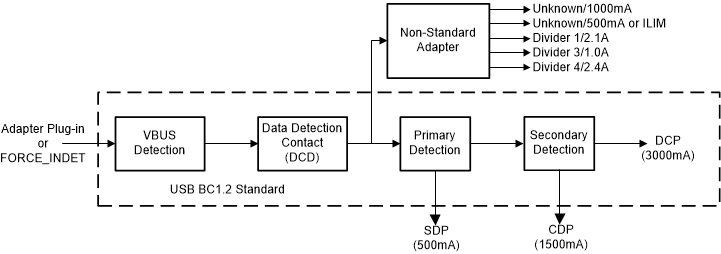ZHCSJ56C February 2018 – September 2019 BQ25882
PRODUCTION DATA.
- 1 特性
- 2 应用
- 3 说明
- 4 修订历史记录
- 5 Device Comparison Table
- 6 Pin Configuration and Functions
- 7 Specifications
-
8 Detailed Description
- 8.1 Overview
- 8.2 Functional Block Diagram
- 8.3
Feature Description
- 8.3.1 Device Power-On-Reset
- 8.3.2 Device Power Up from Battery without Input Source
- 8.3.3 Device Power Up from Input Source
- 8.3.4 Input Current Optimizer (ICO)
- 8.3.5 Buck Mode Operation from Battery (OTG)
- 8.3.6 Power Path Management
- 8.3.7 Battery Charging Management
- 8.3.8 Integrated 16-Bit ADC for Monitoring
- 8.3.9 Status Outputs (PG, and INT)
- 8.3.10 Input Current Limit on ILIM Pin
- 8.3.11 Voltage and Current Monitoring
- 8.3.12 Thermal Regulation and Thermal Shutdown
- 8.3.13 Battery Protection
- 8.3.14 Serial Interface
- 8.4 Device Functional Modes
- 8.5
Register Maps
- 8.5.1 Battery Voltage Regulation Limit Register (Address = 00h) [reset = A0h]
- 8.5.2 Charger Current Limit Register (Address = 01h) [reset = 54h]
- 8.5.3 Input Voltage Limit Register (Address = 02h) [reset = 85h]
- 8.5.4 Input Current Limit Register (Address = 03h) [reset = 39h]
- 8.5.5 Precharge and Termination Current Limit Register (Address = 04h) [reset = 22h]
- 8.5.6 Charger Control 1 Register (Address = 05h) [reset = 9Dh]
- 8.5.7 Charger Control 2 Register (Address = 06h) [reset = 7Dh]
- 8.5.8 Charger Control 3 Register (Address = 07h) [reset = 0Ah]
- 8.5.9 Charger Control 4 Register (Address = 08h) [reset = 0Dh]
- 8.5.10 OTG Control Register (Address = 09h) [reset = F6h]
- 8.5.11 ICO Current Limit Register (Address = 0Ah) [reset = XXh]
- 8.5.12 Charger Status 1 Register (Address = 0Bh) [reset = XXh]
- 8.5.13 Charger Status 2 Register (Address = 0Ch) [reset = XXh]
- 8.5.14 NTC Status Register (Address = 0Dh) [reset = 0Xh]
- 8.5.15 FAULT Status Register (Address = 0Eh) [reset = XXh]
- 8.5.16 Charger Flag 1 Register (Address = 0Fh) [reset = 00h]
- 8.5.17 Charger Flag 2 Register (Address = 10h) [reset = 00h]
- 8.5.18 FAULT Flag Register (Address = 11h) [reset = 00h]
- 8.5.19 Charger Mask 1 Register (Address = 12h) [reset = 00h]
- 8.5.20 Charger Mask 2 Register (Address = 13h) [reset = 00h]
- 8.5.21 FAULT Mask Register (Address = 14h) [reset = 00h]
- 8.5.22 ADC Control Register (Address = 15h) [reset = 30h]
- 8.5.23 ADC Function Disable Register (Address = 16h) [reset = 00h]
- 8.5.24 IBUS ADC 1 Register (Address = 17h) [reset = 00h]
- 8.5.25 IBUS ADC 0 Register (Address = 18h) [reset = 00h]
- 8.5.26 ICHG ADC 1 Register (Address = 19h) [reset = 00h]
- 8.5.27 ICHG ADC 0 Register (Address = 1Ah) [reset = 00h]
- 8.5.28 VBUS ADC 1 Register (Address = 1Bh) [reset = 00h]
- 8.5.29 VBUS ADC 0 Register (Address = 1Ch) [reset = 00h]
- 8.5.30 VBAT ADC 1 Register (Address = 1Dh) [reset = 00h]
- 8.5.31 VBAT ADC 0 Register (Address = 1Eh) [reset = 00h]
- 8.5.32 VSYS ADC 1 Register (Address = 1Fh) [reset = 00h]
- 8.5.33 VSYS ADC 0 Register (Address = 20h) [reset = 00h]
- 8.5.34 TS ADC 1 Register (Address = 21h) [reset = 00h]
- 8.5.35 TS ADC 0 Register (Address = 22h) [reset = 00h]
- 8.5.36 TDIE ADC 1 Register (Address = 23h) [reset = 00h]
- 8.5.37 TDIE ADC 0 Register (Address = 24h) [reset = 00h]
- 8.5.38 Part Information Register (Address = 25h) [reset = 11h]
- 9 Application and Implementation
- 10Power Supply Recommendations
- 11Layout
- 12器件和文档支持
- 13机械、封装和可订购信息
8.3.3.2.1 D+/D– Detection Sets Input Current Limit
The BQ25882 contains a D+/D- based input source detection to program the input current limit. The D+/D- detection has three major steps: Data Contact Detect (DCD), Primary Detection, and Secondary Detection.
 Figure 18. D+/D– Detection Flow
Figure 18. D+/D– Detection Flow Table 2. Non-Standard Adapter Detection
| NON-STANDARD ADAPTER | D+ THRESHOLD | D– THRESHOLD | INPUT CURRENT LIMIT |
|---|---|---|---|
| Divider 1 | VD+ within VD+D-_2P8 | VD– within VD+D-_2P0 | 2.1 A |
| Divider 3 | VD+ within VD+D-_2P0 | VD– within VD+D-_2P8 | 1 A |
| Divider 4 | VD+ within VD+D-_2P8 | VD– within VD+D-_2P8 | 2.4 A |
| Unknown 2 | VD+ = 1 MΩ to 0 V | VD- = 3.3 V | 1.0 A |
After the Input Source Type Detection is done, an INT pulse is asserted to the host. In addition, the following registers including Input Current Limit register (IINDPM), and VBUS_STAT are updated as below:
Table 3. Input Current Limit Setting from D+/D– Detection
| D+/D– DETECTION | INPUT CURRENT LIMIT (IINDPM) | VBUS_STAT |
|---|---|---|
| USB SDP (USB500) | 500 mA | 001 |
| USB CDP | 1.5 A | 010 |
| USB DCP | 3.0 A | 011 |
| Divider 3 | 1 A | 110 |
| Divider 1 | 2.1 A | 110 |
| Divider 4 | 2.4 A | 110 |
| Unknown 5-V Adapter (1) | 500 mA | 101 |
| Unknown 5-V Adapter (2) | 1000 mA | 101 |